INSTRUCTIONS:
For Week 3: Name the soil horizons in each of the following profiles. Click to see answers.For Week 4: Name the (Soil Taxonomy) diagnostic horizons and soil order for each soil. Also, name the parent material for the soil, the drainage class and indicate whether it is well suited or poorly suited for agricultural, forestry or urban use.
Click to see answers.
1. CENTRAL OHIO; on upland, in pasture, 2-6% slope (depth scale in feet).

___ 0-8”, v. dark brown (10YR 3/2) loam; medium granular structure; moderately acid; gradual, wavy boundary.
___ 8-15”; pale brown (10YR 6/3) loam; weak granular structure; moderately acid; gradual, irregular boundary.
___ 15-24”, brown (7.5YR 5/4) loam to clay loam; weak blocky structure; slightly acid; clear smooth boundary.
___ 24-40”, brown (7.5YR 4/4) clay loam; moderate blocky structure; few clay films; neutral; clear smooth boundary.
___ 40-48”, yellowish brown (10YR 5/6) loam; weak blocky structure; few quartz pebbles; neutral.
2. CENTRAL MICHIGAN; hill crest on rolling topography, in pasture.
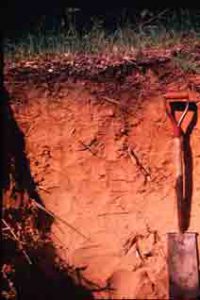
___ 0-6″, dark greyish brown (10YR 4/2) loamy sand; granular structure; many fine roots; moderately acid; gradual irregular boundary.
___ 6-14″ greyish brown (10YR 5/3) loamy sand; weak granular structure;
___ 14-28″, yellowish red (7.5YR 6/8) loamy sand; single grained; few coarse roots; strongly acid; clear smooth boundary.common fine roots; strongly acid; gradual smooth boundary.
___ 28-60″+, v. pale brown (10YR 7/4) loamy sand; single grained; strongly acid.
3. N. GEORGIA, on nearly level floodplain, in woods.
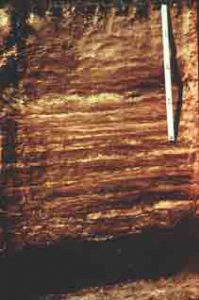
___ 0-6″ dark brown (10YR 3/3) loam; granular structure; many fine and medium roots; few mica flakes; medium acid; abrupt, sooth boundary.
___ 6-18″, yellowish brown (10YR 5/4) sandy loam; weak granular structure; common medium roots; common mica flakes; medium acid; clear, smooth boundary.
___ 18-30″, brown (10YR 4/3) loamy sand; single grained; few coarse roots; many mica flakes; strongly acid; abrupt boundary.
___ 30-60″+, stratified dark brown, pale brown, and light brownish grey loamy sand, sand, and loamy material in bands 1/2-4″ thick; common mica flakes throughout; medium acid.
4. APPALACHAIN MOUNTAINS, on backslope (15-25% slope), in hardwood forest.
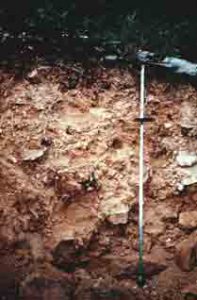
___ 0-1″ hardwood leaves and twigs.
___ 1-5″, dark brown (10YR 3/3) loam; moderate granular structure; few rock fragments; medium acid; clear, smooth boundary.
___ 5-14″, brown (10YR 5/3) loam; weak granular to weak blocky structure; common (10%) medium rock fragments; medium acid; clear boundary.
___ 14-28″, yellowish brown (10YR 5/6) loam; weak blocky structure; 10-20% medium to coarse fragments; slightly acid; clear boundary.
___28-40″+, pale brown (10YR 6/3) loamy soil intermixed with 50-60% hard limestone fragments; fragments range from 1″-8″ along long axis; structureless; few coarse roots; neutral.
5. MONTANA, on level topography, in grassland.

___ 0-14”, very dark brown (10YR 2/2) silt loam; strong granular structure; many fine grass roots; slightly acid; clear, wavy boundary.
___ 14-20”, white (10YR 8/1) silt loam; weak granular structure; few roots; medium acid; clear, undulating boundary.
___ 20-34”, strong brown (10YR 5/6) silty clay loam; moderate subangular blocky structure; few clay films on ped faces; few fine roots; slightly acid; gradual boundary.
___ 34-42”, brown (7.5YR 5/3) silt loam; weak subangular blocky structure; few quartz pebbles; neutral; gradual boundary. ___ 42-60’+, light yellowish brown (10YR 6/4) silt loam; massive; common quartz pebbles; neutral.
6. SOUTH AFRICA (tropical climate), 2-6% slope, on broad upland; in sugar cane field.

___ 0-10”, dark reddish brown (5YR 3/3) clay loam; strong granular structure; moderately acid; many fine roots; abrupt smooth boundary.
___ 10-14”, red (10R 4/8) clay; moderate blocky structure; few medium and fine roots; moderately acid.
___ 14-60”+, dusky red (10R 3/4) clay; strong blocky structure; slightly acid.
7. MAINE, 0-2% slope, on upland flat, in pine forest.
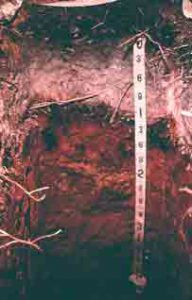
___ 0-2”, loose and matted pine needles.
___ 2-6”, very dark brown (10YR 2/2) sandy loam; moderate granular structure; many coarse and fine roots; few pebbles; very acid; gradual, wavy boundary.
___ 6-12”, white (10YR 8/1) sandy loam; weak granular structure; few coarse roots; few pockets of dark brown loamy sand; abrupt boundary; very strongly acid.
___12-36”, banded dark brown (10YR 3/3) and dark reddish brown (2.5YR 3/4) sandy loam; weak blocky structure; few coarse roots; few quartz pebbles; strongly acid.___ 36”+, yellowish red (5YR 5/6) sandy loam; massive; few pebbles; strongly acid.
8. SOUTH GEORGIA, on nearly level upland (2-4% slope), in cultivated field.
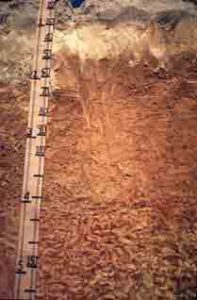
___ 0-10”, grayish brown (10YR 5/2) loamy sand; weak granular structure; few fine roots; slightly acid; abrupt smooth boundary.
___ 10-19”, light grey (10YR 7/2) loamy sand; fine grained; few fine roots; moderately acid; gradual boundary.
___ 19-28”, brown (7.5 YR 5/4) sandy loam; weak subangular blocky structure; few hard iron concretions; moderately acid.
___ 28-44”, yellowish brown (10YR 5/8) sandy clay loam; moderate subangular blocky structure; yellowish red (5YR 5/6) and red (2.5YR 4/8) masses of iron accumulation; very strongly acid; gradual boundary.
___ 44- 60”+, yellowish brown (10YR 5/8) sandy clay loam; moderate subangular blocky structure; few distinct clay films on faces of peds; few ironstone nodules; common red (2.5YR 4/6) and light gray (10YR 7/2) mottles; very strongly acid.
9. ATHENS/CLARKE CO., GEORGIA; in upland pasture on 2-6% slope.
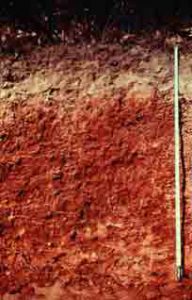
___ 0-5”, dark grayish brown (10YR 4/2) sandy loam; weak granular structure; many fine roots; strongly acid; abrupt wavy boundary.
___ 5-9”, light brown (7.5YR 6/3) sandy loam; weak granular structure; many fine and medium roots; few pebbles of quartz; strongly acid; clear smooth boundary.
___ 9-16”, yellowish red (5YR 4/8) sandy clay loam; weak subangular blocky structure; strongly acid.
___16-38”, red (2.5YR 4/8) clay; moderate subangular blocky structure; common thin clay films on faces of peds; common fine flakes of mica; strongly acid; gradual smooth boundary
___38-48”, red (2.5YR 5/8) clay loam; common strong brown mottles; weak blocky structure; few thin distinct clay films peds; common fine flakes of mica; strongly acid.
___48”+, mottled red, strong brown, and pale brown loamy saprolite of gneiss; massive; common fine flakes of mica; strongly acid.